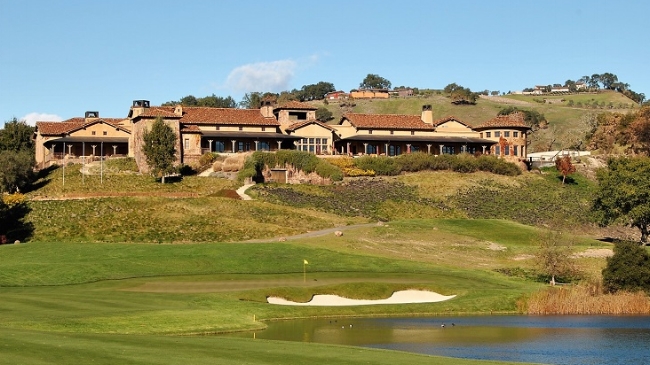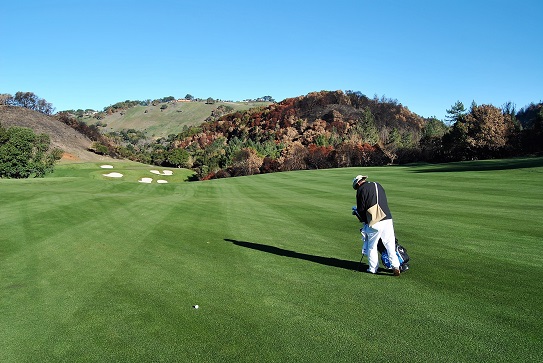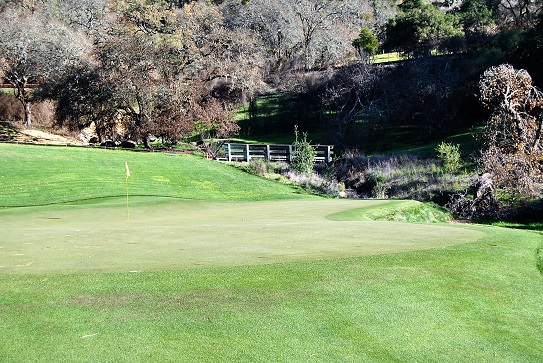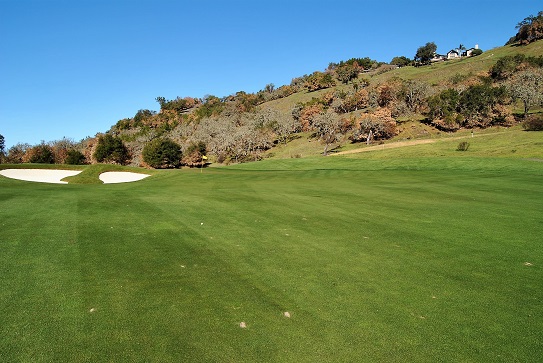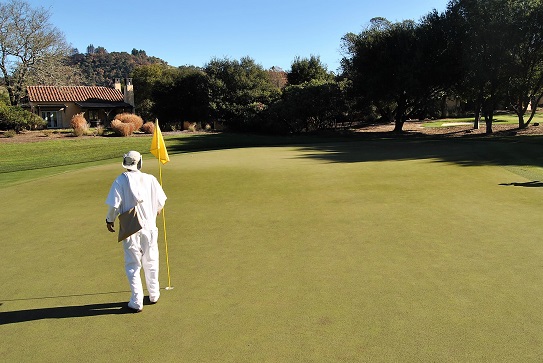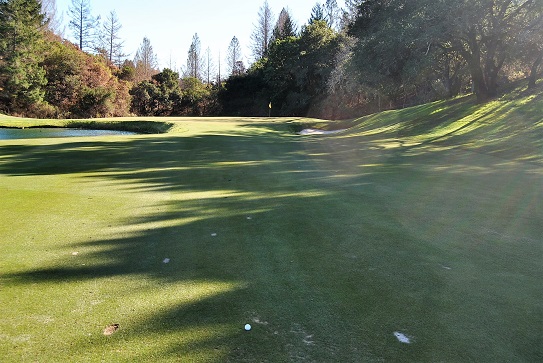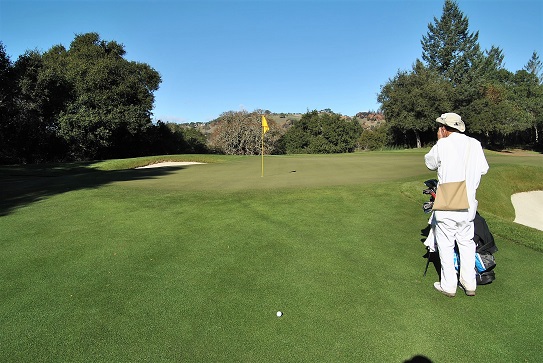Over the first six months of my one year quest to play the top 100 courses in the US as rated by Golf Digest for 2017-18, there have been power outages, multiple hurricanes, and wild fires. Through it all, I’ve remained focused on achieving my goal. I believe circumstances should never be used as an excuse for not achieving a goal. I believe that they are just factors that must be dealt with effectively to achieve the goal. I thought that belief was going to be severely tested when the fires in Napa Valley threatened to destroy Mayacama Golf Club. Mayacama is rated as the 99th course in the Golf Digest top 100. My backup plan was to find out what the 101st course was and substitute it for Mayacama. I’m not sure what impact that would have on claiming to play the top 100 courses in a year. Fortunately, the golf gods formed a shield around Mayacama and protected most of it from the fires.
The fires came within feet of the clubhouse before turning away. The most damaging impact on the club were bridges on the par five fifteen hole. That hole is temporarily played as a par three until the bridges can be repaired. So, on a beautiful sunny day in Napa Valley, I was set to play golf at Mayacama.
On the day before as I left the Olympic Club to head north to Santa Rosa, I noticed the door ajar light was on for the tailgate on my rental car, the customary Jeep Grand Cherokee. I stopped and checked the door, it was closed but the malfunction caused the dome light to remain on and the door ajar light to illuminate. I decided that these were issues I could manage. I continued my drive to Santa Rosa.
After checking into my hotel in Santa Rosa, I discovered another issue, the dome light remained on after the engine was turned off. I was now concerned that if the light stayed on overnight, the battery would drain. I called roadside service for National Car Rental to report the problem. Much to my surprise, they informed me that there was an airport in Santa Rosa. Furthermore, the airport had a National Car Rental location where I could swap out my rental. The airport was only about 10 minutes from my hotel.
Upon arriving at the airport, I noticed several statures of Peanuts characters. This puzzled me. Then I noticed that the airport was named after Charles Schulz. Did you know that Charles Schulz lived and died in Santa Rosa? There are tributes to him and his Peanuts characters all around Santa Rosa. I later also learned that Mayacama was built on property once owned by Charles Schulz.
Upon arrival at Mayacama, I settled up in the pro shop and headed to the driving range. My round at Mayacama was arranged for me by a member, David. I was introduced to David, by Jeff Johnson, the President at Flint Hills National, the second course I played during my quest.
My caddie Randy joined me on the practice range. Randy is former cabinet maker who had to sell his business after things got rough following the downturn in 2008-2009. He is a proud father of two kids who are serving our country in the Air Force.
After warming up, Randy and I headed to the first tee. I chose to play from the Plates tees. The course measures 6300 yards from there with a rating of 71.5 and a slope of 139. The first hole is a 405 yard par four that plays fairly straight from the tee to the green. There are trees lining the right side of the fairway through the green. The left side has trees just past the tee box but is fairly open after that. There is very little room on either side of the 40-50 yard wide fairway. I hit my first drive of the round 260 yards down the left middle of the fairway.
There were 130 yards between my ball and a front middle pin on a green with two bunkers off the left side. My approach shot landed pin high on the right side of the green and rolled off.
I putted from off the green to six feet from the flag.
I made the six-foot putt to open my round with a par.
The second hole is a 510 yard par five. It is the first and most difficult of the three par fives on the front nine. It is rated as the toughest hole on the course. The tee box on the hole is elevated above the fairway. There is a ravine that separates it from the fairway. The carry over the ravine and all the trees in it is about 120 yards. The first 125 yards of the fairway is straight. The straight portion is followed by couple of s curves that wind their way to the green. The fairway gets increasingly narrow from about 100 yards in. I hooked my drive to the left rough.
I hit my second shot back to the fairway leaving 220 yards to a well bunkered green. There is a cluster of four bunkers short of the green on the right and one bunker each on each corner of the green. The fairway way is only about 10 yards wide as it nears the green. The green also slopes off to the right into a ravine. Not quite what you like to have when your approach shot is 220 yards out.
Naturally, I favored the left on my approach shot. The ball landed in the fairway, 40 yards short of the back left pin position.
I pitched onto the green to three feet left of the flag.
I made the putt for my second par in a row.
The third hole is the first par three at Mayacama. The hole was playing 160 yards and most of it was carry over a tree filled ravine. The pin was on the back left portion of the green, tucked behind two bunkers off the front left portion of the green. I hit a 7 iron a little fat. The ball landed on the right front portion of the green. It paused for a moment and then rolled off the front of the green and then down the slope into the rough.
Randy said that all I needed was another foot or so and the ball would have remained on the green. I pitched on to 15 feet right of the flag.
I missed my par putt when the ball broke a little bit more than we expected. It was my first bogey of the round, even so, I was off to a good start.
The fourth hole is the second of the three par fives on the front nine. It measures just 475 yards. The tee box and fairway are separated by the same ravine I played over on the par three third hole. The ravine isn’t in play because it is just off the front of the tee box. There are however trees near the ravine that frame the opening to the fairway which starts at about 100 yards from the tee. There is a bunker on the right side of the fairway, but its easily carried with a drive over 200 yards. My drive came off the club face to the left. The trees blocked our view, but Randy said it was probably in the left rough just off the fairway. He was right, but unfortunately it wasn’t a very long drive.
The fairway narrows significantly at about 180 yards from the green. There is a tree to the left of the narrow strip of fairway. The fairway gets extremely wide after the narrow strip. My second shot hit the aforementioned tree and came down under it.
Best I could do was punch the ball out to the fairway, leaving 105 yards to a back middle pin on a very interesting green.
There is a tree off the front of the green, a bunker between the tree and the green, and a bunker off the back right of the green. I hit a sand wedge over the tree to 25 feet right of the pin.
I left my par putt a foot short of the cup and tapped in for my second bogey in a row.
The fifth hole is another par three that requires a full carry to reach the green. There are trees along the right. The left is wide open. The green is below the tee box but elevated above a low area. There is a single bunker on the right side of the green and two along the left side on a slope that goes down to a dry creek. I hit my tee shot left into the dry creek.
I pitched over the bunker onto the green and two putted for a bogey. I was now finding pars hard to come by.
The sixth hole looks like a simple hole from the tee. It’s a 390 yards par four. It has a wide fairway. There aren’t a lot of trees to worry about on the drive and there is just one fairway bunker at about 235 yards from the tee. I hit my drive to the middle right portion of the fairway, just left of the single fairway bunker.
This hole is all about the approach shot. What looked simple from the tee, just got serious and complicated from the fairway. The fairway drops off into a ravine at about 90 yards from the middle of the green. There are trees along the ravine that frame the opening to the green. The pin was on the back of the green, tucked been a bunker off the front left of the green. To avoid the bunker and still get back to the pin, I tried to hit a draw. The ball stayed out to the right and landed in a bare area to the right of green.
I chipped on and two putted for a bogey.
The seventh hole is the second easiest hole on the course. It is a 305 yard par four. There is a 150 yard carry over rough and past a couple of trees to right of the fairway. The rough between the fairway and the green is one of the areas that was impacted by the fires. The fairway is wide up to about 80 yards from the green. At that point it narrows and makes a hard left turn toward the green. There is a bunker on the outside of the turn. A creek separates the end of the fairway from the green. I decided to hit my three hybrid off the tee. I topped the ball, it landed in the burned out area.
I was happy to find the ball. I laid up to the fairway well short of the bunker, leaving 140 yards to the green.
I hit my third shot to 20 feet below the flag.
My par putt missed one foot to the left of the hole. I tapped in for another bogey. After seven holes, I hadn’t come close to making a double bogey, but I also hadn’t made a par since the second hole.
The eight hole is a 390 yard par four. It has a narrow fairway that widens some as it passes a couple of bunkers off to the right and makes a slight right turn toward the green. There a several clusters of trees along the left and right sides of the fairway. The wind picked up as I addressed the ball. I hit my drive into a strong wind. The ball traveled about 220 yards and landed in the fairway just left of center.
The fairway rises to an elevated green with a paper clip like bunker off the right front. I hit my approach shot on a line straight at the flag. The strong wind knocked the ball down well short of the green.
I pitched onto the green. The ball ended up much better than it should have. The face was a little open on my pitch. I got lucky, the ball stopped just 10 feet right of the flag.
I made the putt and finally recorded another par.
The par 37 front nine ends with the last of the three par fives. The ninth hole measures 515 yards and is rated as the third hardest hole on the course. The fairway starts just past trees that frame it and just over a creek. There is a 170 yard carry from the tee to the beginning of the fairway. The fairway slopes from right to left. I hit my drive to the left edge of the fairway, the ball rolled into the first cut of rough at 285 yards from the middle of the green.
I hit my second shot to the middle of the fairway leaving 115 yards to a front right pin position on a long narrow green with a bunker off the left side. I pulled by approach shot badly. The ball barely cleared the bunker on the left and then rolled toward the back of the green leaving a long and difficult putt.
I pulled by approach shot badly. The ball barely cleared the bunker on the left and then rolled toward the back of the green leaving a long and difficult putt.
I left my birdie putt well short of the flag.
My par putt looked good all the way until it didn’t. The ball broke just inches short of the cup. I tapped in for a three-putt bogey to finish the front nine with a 43 and not a single double bogey.
As Randy and I walked off the ninth green, he told me that we had just finished the flat part of the course. He said the back nine would have more elevation changes and be much more scenic. I thought the front nine was pretty scenic.
The back nine opens with a 375 yard par four. A hole that I think is tougher than its rating, especially when played for the first time. Randy tried to describe the hole, but I didn’t really get it until after my tee shot. Randy called the hole mind numbing. He said members dreaded tournaments where they started on the back nine or shotgun starts where the 10th hole is the first hole for one of the groups. He said it is the worst hole at Mayacama to start your round. There is a hazard on the left and out of bounds on the right.
The fairway makes an almost 90 degree turn toward a green that is across a ravine, has a bunker off the front left and trees tight along the back left. My drive hit in the left portion of the fairway but took a bad kick to the left and landed on the slope off the left side.
The trees on the left side of the fairway were now blocking my approach shot. This is when I understood why it was very important to hit the tee shot to the right even with the risk of the out of bounds on the right. The green was only 135 yards away. I attempted to hit a nine iron over the trees to the green. I’d been swinging the clubs well, so rather than playing it safe and pitching to a spot in the fairway that would leave a straight and clear shot to the green, I attempted the riskier shot.
It didn’t end well. My ball hit the top of the trees and dropped into the hazard. I had to drop 85 yards from the flag. I hit my 60-degree wedge to seven feet right of the pin. I made the putt to save bogey.
The eleventh hole is the longest of the five regular par threes on the course. It measures 185 yards from the Plates tees. Like the previous par threes there is a ravine between tee box and the green. This one is closer to the green than the tee box. There is a bunker off the right side of the green. The pin was set on the front right of the green. I hit my tee shot to just short of the green. The ball rolled back down the slope a few feet farther away from the green.
I putted from off the green to fifteen feet below the hole.
I made the putt for a par.
Randy told me that the 410 yards par four twelfth hole normally plays into the wind. Today it was playing with a helping wind. It’s rated as the second most difficult hole on the course. The fairway is shaped like a string bean with three peas in it spaced close to evenly apart. It curves left to right and then back to the left. There are trees tight along the right side. The left side has some sparse trees. The tee shot to the fairway is over a tree filled ravine, but the carry is less than 100 yards. I hit my drive to the left fairway.
My approach shot was short and to the right.
I pitched on and two-putted for a bogey.
The thirteenth hole a 370 yard par four with a narrow fairway that slopes slightly from right to left. The trees on the left are extremely tight in the landing zone. There are two bunkers in the fairway on the right in the landing zone. The landing zone is between 230 to 250 yards off the tee. I hit my drive to just left of the first fairway bunker.
The fairway bends slightly from right to left toward the green. There is a dry creek just short of the front of the green and a bunker on the right side of the green. My approach shot landed in the creek short of the green.
I hit out of the dry creek bed to six feet short of the hole which was cut on the front of the green. My par putt burned the hole and stopped just past it. I tapped in for yet another bogey. I was disappointed that I wasn’t taking full advantage of some good drives by making more pars. But on the other hand, most of the bogeys were tap-ins and I had not yet made a double bogey through thirteen holes. I’d only had one round during my quest where I was double bogey free. If I could hold it together, I was on track to have another one.
At 140 yards, the par three fourteenth hole is the shortest hole on the course. It is also the first par three on the course without a ravine between the tee box and the green. But don’t let any of this fool you. This hole has a few tricks up its sleeve. The green looks like a square with rounded corners. There is a bunker off the right front, a few yards short of the green. There is another one just in front of the green. There is a strip of fairway that runs from the front of the green between these to bunkers. It slopes right to left.
I hit what I thought was a nice, but short tee shot. The ball landed in the fairway just four feet short of green. The ball rolled down the fairway into the rough 35 feet away.
My pitch shot landed in the bunker in front of the middle of the green. My sand shot landed on the green right of the flag. I made the putt to save bogey. I was just a few feet from a good tee shot and almost ended up with my first double bogey of the round. I breathe a sigh of relief when I was able to get up and down from the bunker.
The fifteenth hole normally plays as a 515 yard par five from the Plates tees. The wildfires destroyed the bridges across a ravine between the end of the fairway and the green. The hole was temporarily playing as a 230 yard par three from what would normally be the forward tees. A temporary green was cut in between a group of three fairway bunkers on the left and one on the right. I hit a three wood off the tee. My ball landed just inside the right edge of one of the bunkers on the left.
My sand shot rolled along the edge of the cup to six feet past.
I made the putt for only my second par on the back nine. Both were on par threes.
The sixteenth hole is the shortest par four and easiest hole on the course. The hole measures 300 yards but only 100 of those yards is fairway. The fairway is also only 35 yards wide. There is 180 yard carry from the tee box over rough and a 30 yard deep green. I hit my 3 hybrid off the tee down the middle of the fairway. It was probably one of the purest shots I’ve ever hit. The ball flew straight and traveled 240 yards.
There were 55 yards remaining to a middle pin on a green with water on the left and a bunker off the right front. I pitched on to 15 feet left of the hole.
I hit my birdie putt a little too hard. I missed the hole, but made the comeback putt for par.
The seventeenth hole is the third regular par three on the back nine. There is a total of four with the fifteenth hole temporarily playing as a par three. It is the second of the regular par threes without a ravine between the tee box and the green. The only trouble on the hole were there trees along the left and the three bunkers around the green. There are two bunkers along the right side of the green and one on the left side. The hole measures 170 yards to the middle of the green but was playing shorter with the pin on the front of the green. There was a swirling wind, so Randy and I had some trouble deciding on which club to hit. We decided to play the number, 160 yards. I hit a seven iron right at the flag. The ball landed a couple of yards short of the green.
I putted from off the green to two feet and made the putt for par.
I had now arrived at the eighteenth hole without a double bogey for only the second time during my quest. The 18th hole is the longest par five on the course. It measures 525 yards from the Plates tees and is rated as the six most difficult hole on the course. There is a tree filled ravine between the tee box and the fairway, but there is only a 130 yard carry to the beginning of the fairway. There is a fairway bunker on the right at about 220 yards out. Water comes into play on the right from about 200 yards from the green and continues to the green. The fairway curves around the water and move right as it approaches the green. There is a bunker along the right side of the green.
The hole was playing into a very strong wind. My drive traveled just 200 yards leaving 325 yards to the green. I hit my driver off the deck but topped the ball. It rolled 100 yards. I got very conservative after that to avoid bringing a double bogey into play. I laid up to 115 yards with my third shot.
I hit my fourth shot onto the green, twenty five feet below the hole.
My putt missed the hole on the high side and stopped two feet past the cup. I made the putt to end my round with a bogey and a 38 on the back nine. The 38 was 5 over par with the fifteenth hole playing as a par three rather than a par five. The back nine normally plays to a par 35 with three par threes, four par fours, and two par fives. My total score was an 82 and for the second time in four rounds, I shot a double bogey free round.
I’d like to thank Jeff for the introduction to David and David for hosting me at Mayacama. This was my final course before taking a break for the Christmas holidays. I had one more course scheduled before the end of the year, Estancia in Scottsdale, Arizona.

